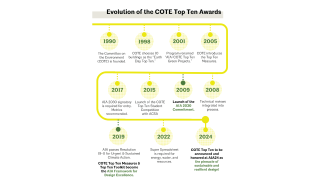
A look into the legacy of AIA COTE and COTE Top Ten Awards
Celebrating the impact of over 30 years of AIA COTE and the AIA COTE Top Ten Award
This article was originally published on Earth Day (April 22) 2024.
On Earth Day 2024, AIA's Committee on the Environment (COTE) celebrated the impact and legacy of the AIA COTE Top Ten Award.
How it all began
The Committee on the Environment (COTE) began when a Critical Planet Rescue (CPR) measure was presented by AIA Kansas City leaders, including Bob Berkebile and Kirk Gastinger, at the 1989 AIA convention in St. Louis. The measure called for AIA to take action to address environmental concerns. Following this success, the leadership of COTE wanted to change the way the profession viewed design excellence. For the next six years, they worked to integrate performance standards into the criteria for the AIA national design awards. In an era marked by intense formalism, this was met with resistance. It was Gail Lindsey, FAIA, who conceived the idea that COTE needed its own awards as a mechanism for agency.
In 1997, the COTE Top Ten was born.[i] Initially called “Earth Day Top Ten,” the pilot program demonstrated that beauty and performance were not mutually exclusive.[ii]
The success of Lindsey’s vision and the group’s hard-won efforts were solidified when the COTE Top Ten Measures and Toolkit became AIA’s “Framework for Design Excellence” and a requirement for national design awards in 2019. Now, the COTE Top Ten Award is fully incorporated into the AIA design awards program as one of the highest honors of design excellence. The Top Ten not only celebrates great design but continues to shape education, discourse, and design excellence while transforming the practice of architecture.

In the spirit of self-reflection, below are some key impacts of the COTE Top Ten:
Redefining Design Excellence
Widespread adoption of the Framework for Design Excellence as well as the integration of metrics as criteria for design awards demonstrates how the AIA COTE Top Ten has shifted the conversation around sustainable design. It is no longer seen as an add on but a key indicator of design excellence.
Increasing Engagement in Energy Reporting
Since the Framework’s adoption, the number of AIA 2030 signatories has significantly grown from 682 signatories in 2018 to over 1,300 today. This is the largest increase since the program’s inception and one indicator that more firms are engaged with sustainable practices.
Pushing the Leading Edge of Sustainability
The COTE Top Ten Award is peer-reviewed by a technical panel with subject-matter experts who look at actual data versus predicted data using the Super Spreadsheet. Every year, COTE evaluates expanded criteria to be included in the Super Spreadsheet as part of the award submission in order to drive change. One recent example is the addition of the social cost of carbon, which makes visible the long-term damage done by carbon emissions to help architects make smarter choices.
Educating Students
With the launch of AIA Top Ten for Students in 2015, in partnership with the Association of Collegiate Schools of Architecture, future architects are being encouraged to take an integrated approach to design that protects and enhances the environment.[iii] Today, 74 schools in 45 states participate in this student competition from across the country and engagement continues to grow with more than 5,000 students participating.
Resources and Tools
The Top Ten award demands rigor and clarity. This simple fact has generated resources and tools to support the needs of architects across project types in service of design excellence. These include:
Growth of an Archive
Architectural archives preserve and provide evidence at the same time they tell us something about the discipline and practices of architecture. The online archive of Top Ten award winners is a powerful reference and generative tool that helps offices build upon the work of industry leaders.
Expanded Knowledge Base
The lessons learned from the analysis of COTE Top Ten winning projects contribute to the collective knowledge base of the profession. From conceptual to practical information, this knowledge is disseminated widely through presentations, publications, and the activities COTE network. The following continue to inform and enlighten:
Influence on Policy and Regulation
Many recognized projects influenced policy and regulation related to sustainable building practices. By showcasing successful examples, the award has had agency in shaping building codes, zoning ordinances, and other regulations to promote a zero-carbon, equitable, resilient, and healthy built environment.
“Regardless of when they are announced and how they are celebrated,” COTE Chair Michelle Amt, FAIA notes, AIA COTE Top Ten Award is “fundamental to COTE’s mission.”[iv] As we look back on this Earth Day, it is clear from the examples above that the legacy of the AIA's COTE Top Ten Award extends far beyond accolades. Yet, it is from the successes of our past that we draw a renewed commitment to reorienting architecture towards the demands of climate action and climate justice.
Happy Earth Day!
[i] https://network.aia.org/blogs/kira-l-gould/2021/01/05/cote-history-practice-transformation-for-a-climate
[ii] COTE-Lessons-from-the-leading-edge_1997-2015.pdf (aia.org)
[iii] AIA COTE® 30th Anniversary Timeline by aiacote - Issuu
[iv] Letter from the Chair -- March/April 2024 (aia.org)
Joyce Raybuck, AIA, LEED AP, is a Design Principal at BNIM in Kansas City with a background in higher education, embassy design, workplace, and urban development projects. Alongside her project leadership, she currently serves on the AIA Committee on the Environment (COTE) Leadership Group.
